II. Stance/Guard
The guard positions are designed to make it more difficult for an opponent to engage my weapon until they are well in range of either the edge or point of my weapon. In the section below entitled “Shield Weapon against Great Weapon”, you will see that the main point of the attack strategy of a shield weapon is to immediately engage and control the great weapon. These guard positions make that difficult; especially the point guards which present a difficult angle for engagement by an opponent.
Part of the way in which this difficulty is achieved is by constructing the guard positions such that it is difficult to predict at which angle an attack will come, other than a direct thrust. This is why I do not use or advise stances what require the weapon to be in a position such as down and to the side, where the attack motions and angles are very predictable.
- Greatsword
High guard
I use this guard against opponents who charge or move in quickly, or against opponents with whom I want to close quickly to force engagement. In these cases, it has more offensive potential than the other guard position. For illustrative purposes, assume a right-handed fighter.
Against right-handed fighters (or any great weapon)
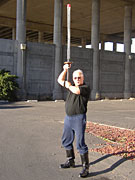
Figure P1a-GS |
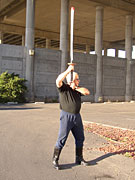
Figure P1b-GS |
- Feet
- Left foot forward
- Feet pointed about 30 degrees to the right of straight forward
- If a line is drawn directly towards the opponent, one foot should be on each side of the line
- Feet a bit more than shoulder width apart, knees bent slightly more than when using a sword and shield.
- Weight balanced
- Body and arms
- Hips rolled under and forward
- Upper body erect
- Left arm bent horizontally across body
- With elbow pointed towards opponent
- Hand just in front of right shoulder, holding butt of weapon
Avoid presenting your forearm or upper arm as a horizontal target, perpendicular to your opponent’s line of advance. This invites a quick, downward swing.
- Right arm held
- With elbow up and back as far as is comfortable
- Forearm tilted up and forward to grasp blade just under hilt
- Grip of right hand may not be firm with all fingers
- Shoulders turned partially to the right, in a similar position to the one used for S&S
- Sword is held vertically.
Against a Left-handed fighter
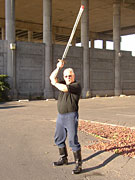
Figure P2-GS |
This is meant for fighting against an opponent with a shield weapon. I am not sufficiently adept that I can use my greatsword with equal facility with either hand. Against an opponent using a great weapon, I use a normal, right-handed guard.
The stance is the same as the High Guard, as described above, but with the point of the weapon tilted so that it is above your left shoulder. This allows, with proper body motion, cuts to the opponent’s shield side, thereby making it difficult for them to “cheat” their shield towards their sword side.
Point Guard
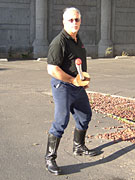
Figure P3a-CS |
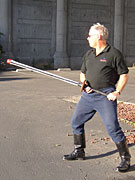
Figure P3b-GS |
I use this guard against opponents who “stalk” me, or move in slowly. In these situations, it has more defensive potential than the other guard position. Usually, I only use this guard against opponents with shield weapons, since I avoid fencing against great weapons. If I did choose to fence at distance against a great weapon, I would use this guard.
- Description
- Assume high guard.
- Take a full stride back with your left foot, so that the relative positions and angles of your feet are reversed, as is the angle of your torso.
- Pull the hilt of the sword back and around your left side, as far back as the position of your arms and body will allow.
- Aim the tip towards your opponent’s face.
- Don’t use against left-handers with shield weapons because your weapon will be on the wrong side of your body, and this will make it difficult to block forehand attacks.
- Naginata
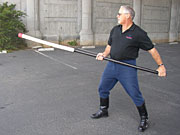
Figure P4a-PW |
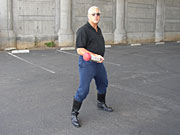
Figure P4b-PW |
This description assumes the fighter using the naginata is a right-handed fighter. In the case of opponents with shield weapons, I always switch hands, so that my back hand is on the side of my body that will be attacked by my opponent’s forehand blows. Against opponents using great weapons, I generally start with the naginata on whichever side I feel most comfortable, and I may switch sides during the fight.
I’ve only used this one stance against single opponents. I’ve just never had the need to add others; nor have I thought of a good reason to do so. The stance is very similar to the Point Guard that I use with the greatsword.
- Feet
- Right foot forward
- Feet pointed about 30 degrees to the right of straight forward
- If a line is drawn directly towards the opponent, one foot should be on each side of the line.
- Feet a bit more than shoulder width apart, knees bent slightly more than when using a sword and shield.
- Weight balanced
- Body
- Hips rolled under and forward
- Upper body erect
- The weapon is held in a roughly horizontal position, the shaft crossing to the front of my body at about the height of my hips, and pointed towards my opponent’s face.
- Hands
- Back hand is right on the butt of the weapon, and is held as far behind me as possible
- This makes my opponent move closer to being in range of my thrusts, if he or she wants to engage my weapon.
- If I’m fighting an S&S fighter, the back hand is on the side that is threatened by his or her forehand blows.
- Front hand holds the weapon fairly close to where it passes in front of my body.
- This allows for more range on intermediate thrusts.
- It slides forward upon contact with your opponent, to allow your hands to be spread fairly far apart for increased leverage.
- Front hand is supinated; back hand is pronated. If you hold the weapon in any other way, it will limit the range of motion of the weapon.
|






